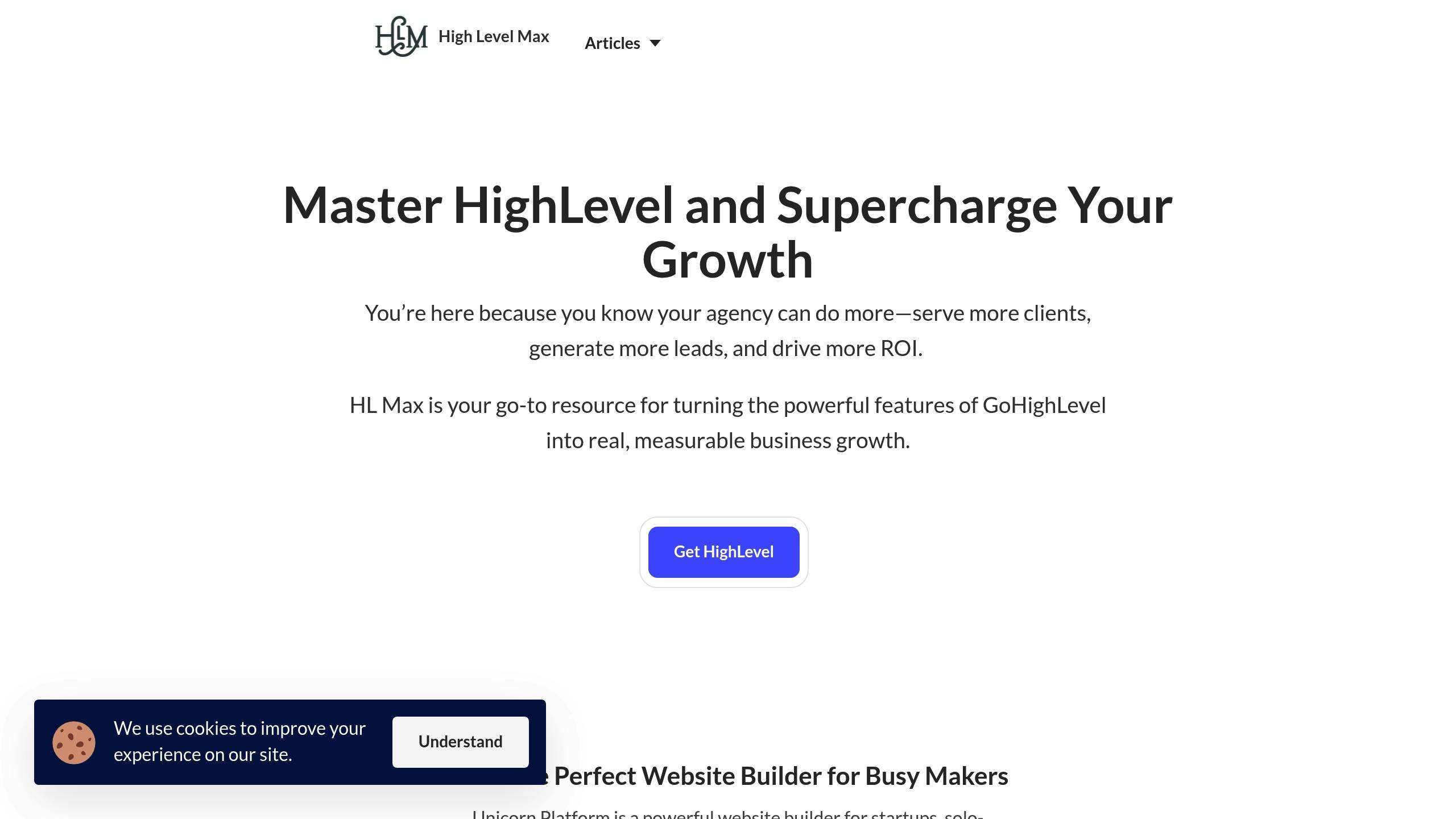A sales pipeline is a step-by-step visual map of your sales process that helps your team track prospects, identify bottlenecks, and close deals more effectively. When done right, it can increase revenue growth by up to 28% and improve team performance by 18%. Here's what you'll learn in this guide:
- Key Stages of a Pipeline: From prospecting to closing, understand the 5–7 stages every pipeline needs.
- Metrics to Track: Conversion rates, sales cycle length, and win rates to measure success.
- How to Improve: Use AI tools, automation, and regular reviews to refine your pipeline.
- Custom Pipelines by Industry: Tailor your pipeline for industries like B2B, marketing, or real estate.
- Tools to Use: Top-rated CRMs like Salesforce, HubSpot, or Pipedrive for better management.
Quick Tip: Businesses with structured pipelines are 10x more likely to achieve consistent revenue growth. Ready to learn how? Let’s dive in.
How to Build a Sales Pipeline & How it Works Over Time
Core Elements of Effective Sales Pipelines
Pipeline Stages Explained
A well-organized sales pipeline typically includes 5–7 key stages, guiding prospects from their first interaction to becoming customers.
| Stage | Purpose | Primary Actions |
|---|---|---|
| Prospecting | Identify potential customers | Research leads, initial outreach, social selling |
| Lead Qualification | Evaluate fit and interest | BANT analysis, discovery calls, needs assessment |
| Demo/Meeting | Highlight solution benefits | Product demos, consultations, technical reviews |
| Proposal | Present formal offer | Share pricing, specifications, ROI analysis |
| Negotiation | Finalize terms and close | Review contracts, address concerns, finalize details |
| Closing | Seal the deal | Contract signing, payment processing, onboarding prep |
| Post-Purchase | Support customer success | Provide implementation support, build relationships |
This framework ensures clear steps and aligns efforts with measurable goals.
Stage Requirements and Metrics
Defining clear criteria for each stage enhances efficiency and results. Companies with structured stage definitions are 10x more likely to achieve consistent revenue growth.
Key metrics to monitor:
- Lead Qualification: Median MQL-to-SQL conversion rate of 20%.
- Proposal: Track pipeline value to estimate opportunity worth.
- Closing: Average win rate across industries is 47%.
- Overall Pipeline: Measure sales cycle length to pinpoint delays.
Tracking these metrics helps teams identify strengths and areas for improvement.
Matching Stages to Customer Decisions
Aligning pipeline stages with customer decision-making improves conversions. By understanding customer behaviors, you can refine your approach for better outcomes.
"Including free demonstrations proved valuable in showing prospects the product's benefits. Although demos take time, they give our prospects the chance to experience the product first-hand before committing to it."
One B2B software company saw a 25% boost in conversion rates within six months by using automated lead scoring tailored to customer decision points.
Here’s how to adapt your pipeline effectively:
- Adjust touchpoints based on customer feedback.
- Track engagement metrics at every decision point.
- Refine stage requirements to reflect customer needs.
- Monitor conversion rates and engagement to identify and resolve friction.
While consistency is key, your pipeline should remain flexible enough to accommodate various customer journeys, ensuring smooth progression and measurable success at every stage.
Setting Up Your Sales Pipeline
Pipeline Structure and Design
Start by documenting your sales process and defining clear stages that align with your customer's journey. A solid pipeline structure usually includes these key components:
| Component | Purpose | Key Considerations |
|---|---|---|
| Stage Definition | Maps the sales journey | Define clear entry and exit criteria for each stage |
| Task Workflow | Outlines required actions | List specific tasks sales reps must complete |
| Timeline Tracking | Monitors deal progression | Track the average time spent in each stage |
| Success Metrics | Measures performance | Focus on conversion rates between stages |
Adjust these components to fit the unique needs of your industry or business model.
Adjusting Pipelines by Business Type
Different industries require pipelines tailored to their workflows. Here are a few examples:
-
Creative Agency Pipeline:
Project Discovery → Scoping → Proposal → Negotiation -
Construction Industry Pipeline:
Initial Scope → Quote Development → Quote Delivered → Contract Signed -
Financial Services Pipeline:
Investment Research → Initial Conversation → Offer Made → Contract Signed
For instance, B2B software companies may need extended qualification stages, while real estate firms often focus on property-specific steps.
Pipeline Management Tools
Once your pipeline is set up and customized, the next step is to implement tools that help manage it efficiently. Here are some options:
Enterprise-Level Solutions:
- Salesforce (4.4/5 from 23,000+ G2 reviews): Ideal for large organizations
- HubSpot (4.4/5 from 12,000+ reviews): Great for marketing integration
Mid-Market Solutions:
- Pipedrive (4.3/5 from 2,000+ reviews): Known for its visual pipeline management
- FreshSales (4.5/5 from 1,200+ reviews): Offers excellent value for growing teams
When choosing a tool, look for features like:
- Visual pipeline views
- Automated task assignments
- Integration with other tools
- Reporting dashboards
- Mobile-friendly access
Given the average sales cycle of 102 days, select a tool that can handle longer-term relationships while offering a simple, user-friendly experience. This ensures your team can adopt it easily and use it effectively.
sbb-itb-f031672
Pipeline Management and Improvement
Lead Scoring Systems
A lead scoring system helps you prioritize prospects and allocate resources effectively. Build a scoring framework using these factors:
| Criteria Type | Scoring Factors | Example Point Range |
|---|---|---|
| Demographic | Company size, industry fit, budget | 1–25 points |
| Behavioral | Website visits, content downloads, email engagement | 1–35 points |
| Engagement | Response time, meeting attendance, communication frequency | 1–40 points |
Since only 4% of website visitors are ready to make a purchase, focus on leads that show clear buying intent. Use automated scoring triggers to adjust scores based on actions. For example, attending a product demo could add points, while unsubscribing from emails might deduct points. This automation ensures that your team can act on scored leads without delays.
Pipeline Task Automation
Automation can save time and improve efficiency in these key areas:
-
Lead Capture and Distribution
Automatically route leads based on factors like territory, expertise, or deal size. Quick responses are crucial, as 78% of customers buy from the first company to respond. -
Follow-up Sequences
Set up automated email sequences tailored to a prospect's behavior. Since it often takes 5–8 touches to convert a lead, these sequences help maintain consistent communication. -
Task Management
Use automation to send reminders and assign tasks. This is especially helpful for industries with long sales cycles, like SaaS, where the average cycle is 84 days.
Pair automation with regular performance tracking to fine-tune your pipeline and keep processes running smoothly.
Performance Tracking and Analysis
Tracking performance metrics ensures pipeline efficiency and helps identify issues early. Key metrics to monitor include:
-
Pipeline Velocity: Use this formula to measure how quickly deals move through your pipeline:
Pipeline Velocity = (Number of Deals × Average Deal Size) ÷ Length of Sales Cycle (days) - MQL to SQL Conversion Rate: If this rate is lower than expected, better alignment between sales and marketing may be needed.
- Win Rate: A low win rate could point to areas where your sales enablement efforts need improvement.
- LTV to CAC Ratio: For SaaS businesses, an ideal benchmark is around 3:1.
AI-powered analytics can further enhance your pipeline by:
- Detecting at-risk deals through sentiment analysis
- Predicting sales outcomes based on historical data
- Offering real-time recommendations for pipeline adjustments
- Automating lead qualification via chatbots
Pay close attention to stage durations. If deals linger too long in a particular stage, it might signal bottlenecks like slow qualification processes or delayed decision-making. Regular monitoring ensures smoother deal progression and higher conversion rates.
Advanced Pipeline Techniques
ABM Pipeline Integration
ABM (Account-Based Marketing) shifts pipeline management to focus on high-value accounts, making it especially useful for businesses handling large contracts and lengthy sales cycles.
For successful ABM integration, focus on these three key components:
| Component | Execution Plan | Expected Outcome |
|---|---|---|
| Account Selection | Pinpoint companies with strong investment potential | Better conversion rates |
| Team Alignment | Align sales and marketing teams on target accounts | More efficient resource use |
| Personalization | Develop custom content and messaging for each account | Higher engagement levels |
For example, Powell Software saw their conversion rate from MQLs (Marketing Qualified Leads) to SQLs (Sales Qualified Leads) jump from 20% to 28% by equipping SDRs (Sales Development Representatives) with focused LinkedIn data and actionable insights. This tailored approach naturally expands into multi-channel strategies for broader engagement.
Cross-Channel Lead Nurturing
Strong pipeline management thrives on multi-channel lead nurturing. Businesses that excel in nurturing efforts generate 50% more sales-ready leads while cutting costs by 33%.
Here are some effective channels and strategies:
| Channel | Purpose | Best Practice |
|---|---|---|
| Email Campaigns | Direct communication | Use personalized emails to boost response rates 4–10x |
| Social Media | Encourage brand interaction | Build community engagement and establish thought leadership |
| Retargeting | Re-engage potential leads | Reconnect with previous website visitors |
| Educational Content | Provide value to leads | Address key pain points at every stage |
Tailored messaging across these channels can result in nurtured leads making purchases that are 47% larger than those from non-nurtured leads.
High-Value Deal Strategies
Closing large deals means directly tying your solutions to measurable business outcomes. As Marcy Campbell, CRO at Boomi, emphasizes:
"Particularly in today's market, having influence with a C-level decision-maker at the buyer organization is crucial".
Here’s how to refine your strategy for high-value deals:
1. Value-Based Negotiation
Start by defining clear metrics that highlight the business value of your solution. Jim Sullivan, CEO of NWN Carousel, explains:
"When sellers are able to lay the groundwork of business value, supported by metrics that outline the positive business outcome for the buyer, they reach a point of leverage in the negotiation process".
2. Buying Committee Engagement
Instead of focusing on a single stakeholder, target the entire decision-making group. This broader approach has allowed companies like N.Rich to achieve engagement costs 4–5 times lower than traditional LinkedIn Ads.
3. Strategic Content Deployment
Offer content tailored to C-suite priorities, such as High-Value Offers (HVOs), to drive engagement and seamlessly integrate with your overall sales pipeline strategy.
Conclusion: Implementing Your Pipeline
Implementation Steps
Building a sales pipeline that drives results requires focus, the right tools, and consistent follow-through. Start with a solid framework, use reliable technology, and stick to your plan to improve forecast accuracy and fuel growth.
Here’s a phased approach to consider:
| Phase | Key Actions | Expected Impact |
|---|---|---|
| Foundation | Define stages, map the buyer journey, set metrics | Clearer process visibility |
| Technology | Use a CRM, automate tasks, and enable tracking | 30–50% improved forecast accuracy |
| Execution | Train your team, schedule reviews, update data | 20% YoY growth potential |
To calculate your pipeline requirements, work backward from your revenue goals.
Keep your pipeline in top shape by focusing on these key practices:
- Stage Mapping: Match each stage to specific buyer actions and clearly define exit criteria.
- Activity Standards: Outline the necessary tasks for each stage in detail.
- Regular Reviews: Hold weekly pipeline reviews to keep things on track.
- Data Hygiene: Regularly clear out deals that are no longer active to maintain accuracy.
By following these steps, you’ll create a system that supports steady improvement and aligns with earlier strategic insights.
Additional Resources from HL Max

HL Max provides tailored resources to help you set up and refine your sales pipeline with HighLevel. From pipeline setup and lead scoring to automation workflows and tracking systems, our tutorials guide you through every step. Explore more at hlmax.co.
"To ensure uniformity and consistency within your team, it is vital that you document every stage of your sales process, from the initial call to acquisition".



